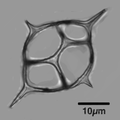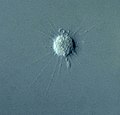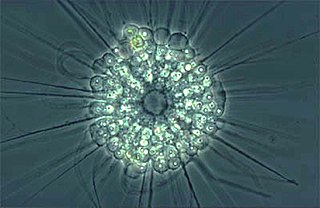
The actinophryids are an order of heliozoa, a polyphyletic array of stramenopiles, having a close relationship with pedinellids and Ciliophrys. They are common in fresh water and occasionally found in marine and soil habitats. Actinophryids are unicellular and roughly spherical in shape, with many axopodia that radiate outward from the cell body. Axopodia are a type of pseudopodia that are supported by hundreds of microtubules arranged in interlocking spirals and forming a needle-like internal structure or axoneme. Small granules, extrusomes, that lie under the membrane of the body and axopodia capture flagellates, ciliates and small metazoa that make contact with the arms.

A flagellate is a cell or organism with one or more whip-like appendages called flagella. The word flagellate also describes a particular construction characteristic of many prokaryotes and eukaryotes and their means of motion. The term presently does not imply any specific relationship or classification of the organisms that possess flagella. However, several derivations of the term "flagellate" are more formally characterized.

The Stramenopiles, also called Heterokonts, are a clade of organisms distinguished by the presence of stiff tripartite external hairs. In most species, the hairs are attached to flagella, in some they are attached to other areas of the cellular surface, and in some they have been secondarily lost. Stramenopiles represent one of the three major clades in the SAR supergroup, along with Alveolata and Rhizaria.

The cryptomonads are a group of algae, most of which have plastids. They are traditionally considered a division of algae among phycologists, under the name of Cryptophyta. They are common in freshwater, and also occur in marine and brackish habitats. Each cell is around 10–50 μm in size and flattened in shape, with an anterior groove or pocket. At the edge of the pocket there are typically two slightly unequal flagella. Some may exhibit mixotrophy. They are classified as clade Cryptomonada, which is divided into two classes: heterotrophic Goniomonadea and phototrophic Cryptophyceae. The two groups are united under three shared morphological characteristics: presence of a periplast, ejectisomes with secondary scroll, and mitochondrial cristae with flat tubules. Genetic studies as early as 1994 also supported the hypothesis that Goniomonas was sister to Cryptophyceae. A study in 2018 found strong evidence that the common ancestor of Cryptomonada was an autotrophic protist.

The silicoflagellates are a small group of unicellular photosynthetic protists, or algae, belonging to the supergroup of eukaryotes known as Stramenopiles. They behave as plankton and are present in oceanic waters. They are well-known from harmful algal blooms that cause high mortality of fish. Additionally, they compose a rich fossil record represented by their silica skeletons.
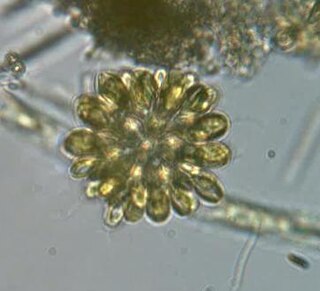
The synurids are a small group of heterokont algae, found mostly in freshwater environments, characterized by cells covered in silica scales.
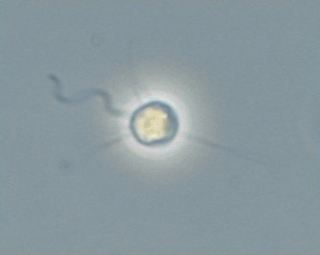
Pedinellales (ICN) or Pedinellida (ICZN) is a group of single-celled algae found in both marine environments and freshwater.
Rhizochromulina is an unusual genus of marine heterokont algae, with one species, Rhizocromulina marina. They are colored amoeboids with a single flagellum, and produce distinctive spindle-shaped zoospores. These have a cell structure typical of the axodines. Before it was studied in detail, Rhizochromulina was included among the superficially similar golden algae in the order Chrysamoebales, but these produce zoospores which are similar to flagellate golden algae in form.

The chlorarachniophytes are a small group of exclusively marine algae widely distributed in tropical and temperate waters. They are typically mixotrophic, ingesting bacteria and smaller protists as well as conducting photosynthesis. Normally they have the form of small amoebae, with branching cytoplasmic extensions that capture prey and connect the cells together, forming a net. These extensions are dependent on the presence of light and polymerization of the actin cytoskeleton. They may also form flagellate zoospores, which characteristically have a single subapical flagellum that spirals backwards around the cell body, and walled coccoid cells.
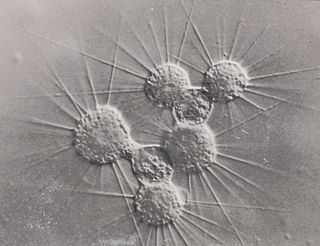
Actinophrys is a genus of heliozoa, amoeboid unicellular organisms with many axopodial filaments that radiate out of their cell. It contains one of the most common heliozoan species, Actinophrys sol. It is classified within the monotypic family Actinophryidae.
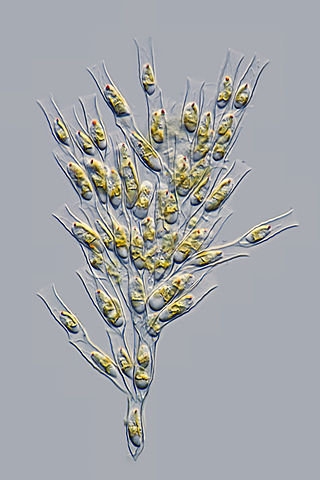
The Chrysophyceae, usually called chrysophytes, chrysomonads, golden-brown algae or golden algae, are a large group of algae, found mostly in freshwater. Golden algae is also commonly used to refer to a single species, Prymnesium parvum, which causes fish kills.

Bicosoecida (ICZN) or Bicosoecales/Bicoecea (ICBN) is an order of Bikosea, a small group of unicellular flagellates, included among the stramenopiles. Informally known as bicosoecids, they are free-living cells, with no chloroplasts, and in some genera are encased in a lorica.

Monadofilosa is a grouping of Cercozoa. These organisms are single-celled amoeboid protists.

Ochrophytes, also known as heterokontophytes or stramenochromes, are a group of algae. They are the photosynthetic stramenopiles, a group of eukaryotes, organisms with a cell nucleus, characterized by the presence of two unequal flagella, one of which has tripartite hairs called mastigonemes. In particular, they are characterized by photosynthetic organelles or plastids enclosed by four membranes, with membrane-bound compartments called thylakoids organized in piles of three, chlorophyll a and c as their photosynthetic pigments, and additional pigments such as β-carotene and xanthophylls. Ochrophytes are one of the most diverse lineages of eukaryotes, containing ecologically important algae such as brown algae and diatoms. They are classified either as phylum Ochrophyta or Heterokontophyta, or as subphylum Ochrophytina within phylum Gyrista. Their plastids are of red algal origin.

Kiitoksia is a genus of aquatic protist. The taxonomic position of the genus is still uncertain and it has not found a robust location in any subgroup.

Ultrastructural identity is a concept in biology. It asserts that evolutionary lineages of eukaryotes in general and protists in particular can be distinguished by complements and arrangements of cellular organelles. These ultrastructural components can be visualized by electron microscopy.
Heliorapha is a genus of heliozoan protists, amoeboid eukaryotes with stiff axopodia radiating from their cells. It contains one species, Heliorapha azurina. It is classified within a monotypic family Helioraphidae inside the actinophryids, a group of heliozoa that belong to the Ochrophyta along with other protists such as diatoms and brown algae.
Commation is a genus of marine heterotrophic protists closely related to the actinophryids. It contains two species, Commation cryoporinum and Commation eposianum, discovered in antarctic waters and described in 1993. Currently, the genus is classified within a monotypic family Commatiidae and order Commatiida. Along with the photosynthetic raphidophytes, these organisms compose the class of stramenopiles known as Raphidomonadea.
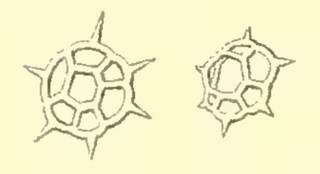
Octactis is a genus of silicoflagellates, marine photosynthetic unicellular protists that take the form of either flagellates or axopodial amoebae. Described by Josef Schiller in 1925, Octactis contains various species of marine phytoplankton, some of them responsible for algal blooms that are toxic to fish.

Pteridomonas is a genus of heterotrophic flagellates belonging to the phylum Ochrophyta. It was described in 1890 by Eugène Penard. Species of this genus descend from a group of photosynthetic algae but have secondarily lost their chloroplasts. They are single-celled flagellates, attached to the substrate by a stalk and distinguished by a ring of tentacles around the single flagellum. They can be found in marine, brackish or freshwater environments.

